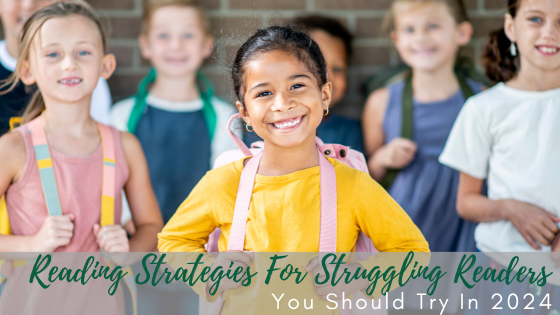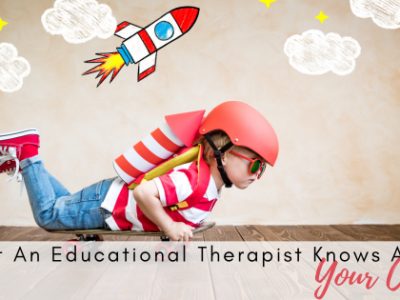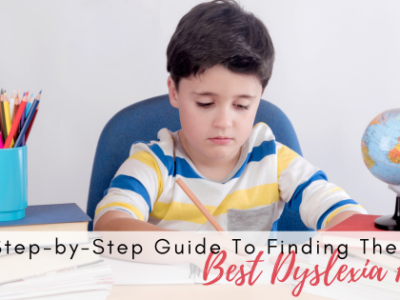
7 Reading Strategies For Struggling Readers You Should Try In 2024
The human brain is a fascinating thing. Neural pathways in the brain can get stronger and faster the more that we use them. The way we learn through repeated experiences helps our brains to create defined pathways that allow us to perform actions more efficiently. One of the skills that this theory applies to is reading. Readers with dyslexia can become better readers through strategic approaches and repeated practice. Finding the right reading strategies can help your dyslexic student to improve in critical areas such as fluency, phonological awareness, and accuracy. Read on to learn about 7 reading strategies for struggling readers that you should try in 2024.
- Place a focus on phonics. Phonological awareness is so key when it comes to instructional focus in reading for students with dyslexia. Put simply: phonics focuses on the sounds in spoken language. In phonics, the smallest sound units—such as the p sound in pie—are the phoneme. When learning reading strategies, readers need to be able to distinguish and segment sounds. Another key part of phonics is recognizing patterns of letters beyond just single letter sounds. Learning phonics can help readers with dyslexia to learn multi-syllable words and word parts like prefixes and suffixes. While phonics is an essential key, it’s not the only one. Adding in morphology, syllable division, decoding and sight recognition creates a powerful integration — much like several threads woven together create a rope that is stronger than its individual parts.
- Tech can be a great tool. For students with dyslexia, adding technology tools for academic purposes can help with learning. When a child listens to audiobooks and reads or follows along with the text of the book, this can help with exposure to more words and with familiarity with the structure of sentences. In addition, there are many apps, text-to-speech tools, and devices that can help students with their approaches to reading.
- Simple texts are foundational. As students advance in their grade level, it is common for the curriculum to include much more complex texts. But for readers who struggle with dyslexia, these more advanced books can be overwhelming. One strategy to help struggling readers is to nurture their pleasure for reading. Having students with dyslexia select and repeatedly read familiar, easier books—with compelling stories and simpler words—can be both engaging and encouraging. This can help to build confidence, competence, and momentum for readers.
- Consider critical elements such as systematic and explicit instruction. Strategies for reading that include systematic instruction can empower struggling readers. Systematic instruction works on building foundational skills with consonants, easy vowel sounds, more difficult vowel sounds and spellings, and word segments. This follows a methodical sequence of decoding skills. Explicit instruction includes directly stating patterns in words, recognizing syllable division patterns, and instruction on prefixes, suffixes, and roots when age appropriate. For example: “-tion” says “shun” is just one pattern of letters to learn. Teaching in an explicit way doesn’t leave students to just figure out reading on their own; it is intentional and tailored to a student’s needs.
- Take a diagnostic approach. Individualized instruction for students with dyslexia can have such a positive impact. When instruction for dyslexic students is based on consistent, thorough assessment it can be so effective. With both informal and formal measures of assessment, dyslexia help can then be tailored to the student’s needs.
- Get organized at home. While it seems like common sense, it can be so helpful for students with dyslexia to have an ideal learning environment at home. Keeping things clean and uncluttered helps dyslexic students to focus. In addition to the physical study space, learning and reading materials ought to be visually simple and clean. Structuring academic routines is essential as well. It is helpful for students with dyslexia to have step-by-step instruction for things like their lessons and class work too.
- Get to know Orton-Gillingham. Being a parent of a child with dyslexia means that you will be learning a lot of new terminology and methods as you learn to help your student. One of the best approaches to dyslexia is Orton-Gillingham, a structured, multisensory approach that focuses on phonemic awareness, blending, and segmenting. This method uses physical activities and visual tools to help reinforce learning.
At Dyslexia on Demand, we do comprehensive intervention for students with dyslexia, which implements the Orton-Gillingham approach. Our dyslexia therapy sessions are led by Certified Academic Language Therapists (CALTs), who are specially trained in dyslexia therapy. The curriculum we use is designed to enable students with dyslexia to achieve and maintain better word recognition, reading fluency, and comprehension.
Does your child struggle with reading, or has your child been diagnosed with a learning disability like dyslexia? Dyslexia on Demand can help. You can be an advocate for your student by working with their school and teachers. And while there are many different approaches to helping struggling readers, know that you can get even more effective, direct instruction with dyslexia therapy through Dyslexia on Demand. We help readers to be academically successful. To learn more, visit the Dyslexia on Demand website, or give us a call at 512-387-6365. Let us educate you about the differences between dyslexia tutoring and dyslexia therapy.







